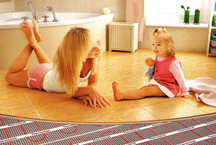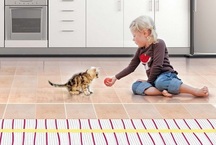Infrared film floor appeared on the market recently, but already has its fans and is rapidly gaining momentum in distribution. What it is, how it differs from other types of underfloor heating, with what kind of flooring it can be used, how it is installed - we will answer these and many other questions further.
What is infrared film floor?
The infrared film floor is a heating system that has received this name due to a thin carbon heating film. Working from the electrical grid and radiating long infrared rays and anions (negatively charged ions) heats the floor covering, its radiation is often called thermal. Carbon paste is applied on the film in even or spiral stripes, coating a full area of the film is permissible. Electricity is transmitted through copper-silver conductors. Electromagnetic radiation from the floor is less than from a household appliance. The radiation does not dissipate and does not heat the air, but is completely transmitted to the surfaces: the floor, walls, objects and the body. Heats all non-transparent objects, and already from them the heat enters the air. During the work no harmful substances are emitted, combustion products are not formed and oxygen does not burn out.
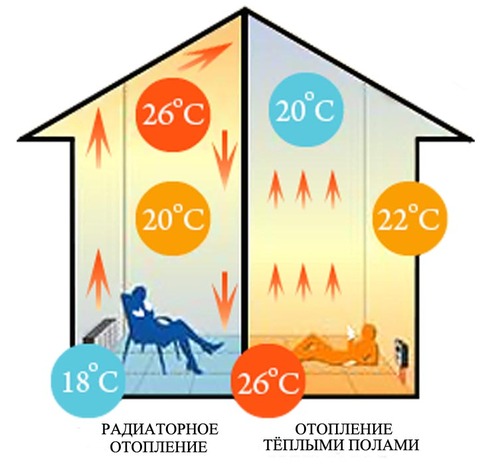
Myths about infrared film underfloor heating
- It takes a long time to prepare the base and tie for laying the elements.
The film floor is laid under any finish, does not require screed. Floor height remains at almost the same level (+ 2-5 mm).
- Expensive.
The set costs from 1500 rub. per square meter, but you do not have to pay for the screed and leveling the floor in the remaining rooms without a warm floor.
- Long.
All types of underfloor heating, except film, require preparation of the screed and its drying (depending on the layer thickness and area of the coating up to 28-30 days). Heating is not recommended to include earlier, so as not to crack the screed and tile. The infrared floor, installed by the dry method, is mounted in an hour and can be used immediately, rather than waiting for the concrete to dry.
- Consume a lot of electricity.
If you compare with heaters or electric cable floor energy savings will be 15-20%.
- Harmful radiation.
Radiation from the floor is "alive", thanks to its spectrum, it heals the body. Similar radiation is used in saunas and incubators for premature babies. The use of such a floor is recommended for apartments and cottages (including wooden). Only short-wave radiation can be dangerous, since it can penetrate into the cells inside the body, and long-wave and terrahertz rays come from the film. Maximum they penetrate the skin, and irritate the nerve endings responsible for the sensation of warmth.
- Radiation does not pass through the floor covering.
The misconception that is widespread on the forums is that heat radiation does not occur. Infrared radiation is not delayed by floor coverings, uniformly heating the floor and surrounding objects and surfaces.
- Not durable.
With quality installation and proper operation, the film floor without repair can work for about 30 years.Perhaps you yourself decide to change the floor before, then the main thing is not to damage the elements. Manufacturers give a guarantee for systems up to 15 years, the film is not damaged by itself and is not susceptible to corrosion. Really reduce the term can:
- Poor quality wire material
- Floor flooding
- Non-compliance or violation of the system installation technology
Installation of film infrared floor
Preparing to install the infrared floor
All debris and dust from the base is removed, it is better to additionally go through with a powerful vacuum cleaner. The surface level is checked, the tolerance of deviation is 3 mm per meter. With a larger tree, the wood is cycled, and the concrete is ground to a horizontal, even base. Thermal and hydro insulation is placed on the cleaned surface. If linoleum or carpet is chosen, then thickness of materials for insulation of 3-5 mm will be enough. The insulation is laid up with the metallized layer up, the joints of the sheets are fixed with aluminum tape. Under ceramic tiles, a good thermal insulation will be a 2 mm technical cork.
On delivery and installation, protect the film from mechanical damage. Prior to the installation of the infrared floor, you need to consider where the thermostat will be located and draw a complete floor plan. The scheme must be preserved, because after a while, you can forget the exact location, and when moving heavy furniture, you can damage the elements. The film is initially mounted only on areas without high point loads, in order to avoid deformation of the film, it fits only in the place not occupied by interior items (furniture on legs, household appliances, etc.).
Film laying
The film is cut along the marked lines and placed on the floor according to the diagram, with contacts to the wall on which the thermostat is located, the elements are laid out with the copper side down. At the edges of the copper strip, contact clips are installed and wires are connected, all the places of the film cut and connections to the clips are carefully insulated. The maximum length of a single uncut film sheet is 7 meters, the material does not overlap.
A temperature sensor is connected on the lower side of the film, it is also isolated. After complete placement of the elements on the base and the connection of wires and contacts, the thermostat is installed and the test begins with the connection to the power grid. The test takes place strictly before laying the flooring, so that if necessary it can be easily repaired or replaced. The absence of sparks and uniform heating of the film indicates a good connection, you can put the finishing layer itself floor covering. For additional protection on the elements fit polyethylene film.
Insulation of thermal elements of the infrared floor using a protective film (dry installation) or pouring cement screed (wet installation). After filling with a screed, the system can be turned on after the screed has completely dried (about 30 days), to prevent the appearance of cracks and the integrity of the film and contacts. Laying the film under the ceramic tiles or porcelain tiles on the system can be applied special glue, and on top of the floor covering. To install the film floor does not require permits, the main thing is to bring a separate power line.
What layers will be near the floor?
Under tile or porcelain tile: hydro and thermal insulation, infrared film, polyethylene film, gypsum fiber 10 mm and tile adhesive and coating are laid on the base.
Under the laminate: hydro and thermal insulation, infrared film, polyethylene film and coating are laid on the base.
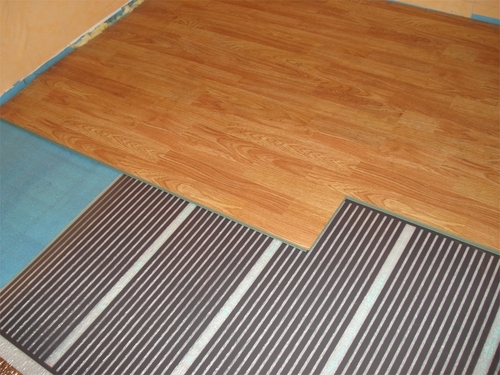
Photo: goryacho.stroimdom.com.ua
When installing an infrared floor under linoleum or carpet: Hydro and thermal insulation, infrared film, polyethylene film, gypsum fiber or 8 mm plywood and coating are laid on the base.
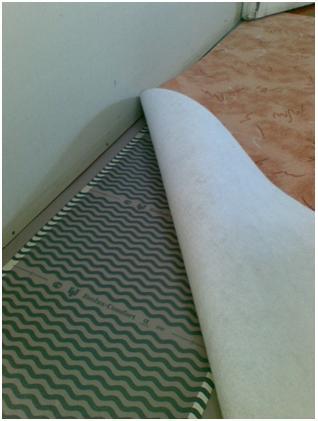
Cutting pieces remained after laying, what can be done with them? You can connect in one lane and use as a portable heating, for example, a rug.
For mounting an infrared floor do it yourself You will need the following tools: pliers, screwdriver, pliers, scissors and a tool for crimping wires. Before working carefully read the instructions and follow the safety precautions when working with electrical wiring.
What floor coverings are recommended for installation on a film warm floor?
If you have a wooden or old (old) house
Installation of film floors is allowed in wooden houses and on a wooden surface without a screed, this solution saves time and money on installation. From above the film floor can be covered with floor coverings: linoleum, carpet, vinyl, laminate. And putting the film just under the carpet can be used in the cold and clean the system for the summer season. In old houses, for fire safety, a separate line of the electrical network with a cross section of 2.5 mm is drawn for the system, the cable is connected to a separate automat in the meter with RCD.
Tile
The most common material - tile, durable, not afraid of mechanical damage to the coating and does not require special care. A wide range of colors, textures, size, and most importantly cost, allows anyone to choose an option that is suitable for the interior and design. Warm floor, warming up, removes its only drawback: always cold.
Porcelain stoneware
Porcelain and natural stone properties are the same as tile, differing only in price per square meter. They quickly heat up and retain heat, with such a coating and high power you can use the floor as a source of main heating. With high-quality insulated room.
Laminate
Using an infrared floor under the laminate will not allow to warm the room, i.e. instead of the main heating will not work. Laminate and carpet retain heat even better, but the substrate under the laminate should be resistant to heat and have a small thickness.
Parquet and floorboard
The parquet and the parquet board can start to dry and crack when it is very hot and requires moisture, the glue base can decompose and the varnish release harmful substances. To avoid all the drawbacks, you need to purchase specialized materials that allow the installation of a heated floor. They are made according to the technology with protection against desiccation.
Why choose film floor?
Benefits
Absolutely silent operation, resistance to damage and corrosion, air ionization, as well as affordable self-assembly system. Heating of objects and the floor occurs evenly, because the distance between the conductors is about 1 cm. Unlike conventional heaters with convection, when the air is heated first, and then the objects. The temperature of the film for home use does not exceed 60 degrees, so you can use any floor covering you like. Easy and quick installation of the system distinguishes the film floor from the other warm floors, the installation takes very little time.
Improving properties
Warming up the body improves blood circulation in the capillaries and peripheral areas, and the increased pressure decreases. Helps relieve fatigue syndrome by relaxing muscles.
Advantages and disadvantages of infrared floor heating
"pros"
- The most progressive method of heating
- Economical heating
- Floor heating takes 3-6 minutes
- Suitable for all types of rooms
- It can be main and additional, as well as wall heating.
- Can install absolutely anyone who read the instructions.
- If necessary, it is easy to dismantle and transport films to another area.
- Eco-friendly, without noise and vibrations
- Does not increase floor height
"minuses"
- If you heat all the rooms in the house, it turns out not too economically
- To use films in the office or at work, firefighters need permission.
- It is difficult to rearrange the furniture, avoiding the heating zones, either not to rearrange or redo the floor. With warm water floors or cable with a coupler, this problem does not occur, through the coupler system can not be damaged by furniture.
Floor installation ...
... in the bathroom and kitchen
In the bathroom and in the kitchen we spend the morning and evening hours, and we should be comfortable. Usually in such rooms it is cold, but it is moisture- and steam-resistant tile. For heating, an electric cable was placed in the screed, but the height of the floor rose, and very often there was not much space. The film in operation is more profitable than cables by about 20%. Screed installation is not needed, which means that the height of the floor will not rise and the useful height of the room will not decrease. Heating strips are connected in parallel, when a single strip fails, the floor will be warm, but uneven, with water or electric (cable) heating the entire system fails at once.
... on the loggia
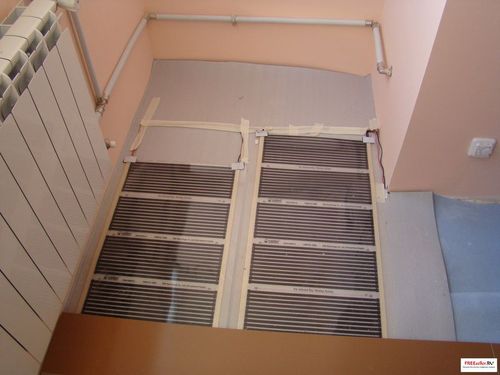
Warming the floor on the loggia or balcony, is not simple. To weight the slab with a concrete screed or heavy pipes with water is not worth it, the slab may not withstand. And in the old and dilapidated houses all the more. Underfloor heating can be a major source of heating for such a small room. An excellent way out of this situation would be to install a film floor: it weighs little, the film is thin, screeding is not required, only a socket is needed. Installation of the film is made on the leveled floor (preparation is required, as it is usually beveled towards the street).
How much is a infrared floor heating kit?
Characteristics and cost grouped by manufacturer
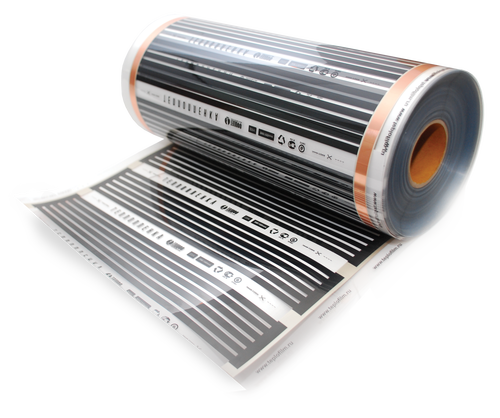
Photo: rvm.su
A film floor at a cost per meter is not cheap at all, but you need to consider that it does not require a screed and special surface preparation. Yes, and heating will be cheaper, so when calculating you need to look not at the price of a running meter, but at the total cost of a turnkey meter plus how much heating will cost per month.
Caleo
CALEO offers flooring for screed installation and without screed. Three line sets without tie: Caleo GOLD, Caleo GRID, Caleo LINE.
Line GOLD with anti-spark technology: 170 W, width 0.5 m, coverage area from 1 to 6 sq.m. price for 1 sq. m. from 1597 rub.
Line GRID has two types of sets: 150 W and 220 W, width 0.5 and 1, the coverage area is from 1 to 20 sq. m. price for 1 m. KV. from 1452 rub.
Line LINE differs in simplicity of production: 130 W, width is 0,5 m, the area is from 1,5 to 6 sq.m. price for 1 sq.m. from 595 rubles.
The installation of the CALEO infrared rod floor screed allows you to install the floor around the perimeter, regardless of the presence of furniture. During operation, it will not overheat. Power depends on the area of coverage, the minimum cost of a set of 2378 rubles.
Teplofol
Teplofol offers a TEPLOFOL-nano heating film with parameters of 140 W and a web width of 0.54 m. One set covers 10 sq. M. cost per 1 sq.m. from 1281 rub.
XiCa Film (RexVa)
The company XiCa Film (RexVa) offers a variety of kits with a capacity of 220 W and an area of heating from 1 to 15 square meters, cost from 1200 rubles. sq.m.
Hot-Film-Korea
Hot-Film-Korea offers discounts on the cost per sq.m. when buying a set for a large area, the cost of 850 rubles per sq. m.
HEAT-PLUS
HEAT-PLUS produce several types of film, and can also make any power per square meter to order. (80 to 450 W). Width is 1 m, thickness is from 0.4 to 0.8 mm, roll length is from 75 to 100 m. Working temperature is from 40-50С (for heating) to 70С (for saunas). The cost of 700 rubles. sq.m.
NanoThermal
The cheapest deals from the company NanoThermal: line COMFORT (160 W, from 611 rubles per 1 sq. M.), Ruler PREMIUM (220 W, from 642 rubles per 1 sq. M.).
What is included in the set of film warm floor?
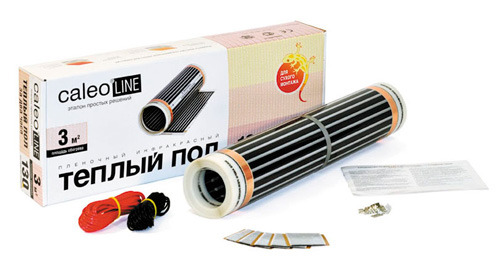
Photo: www.afonya-spb.ru
- The basis of the set is a roll of heating film.
- Connectors for connecting the film to the electrical network.
- For insulation of joints and cuts - insulating tape.
- Wires from the film to the thermostat.
- Corrugated tube for temperature sensor under the floor covering and film.
- Installation and Operating Instructions and Warranty Card
IMPORTANT In addition to the set, it is necessary to purchase a thermostat and thermal insulation (foamed polyethylene of 3-5 mm, protected by a polymer film).
When properly configured, the system consumption is quite economical. To control the system using the following types of devices:
- Thermostats (thermostats)
- Programmable devices
- “Self-learning” programmable devices
Types of infrared floors
Carbon rod mats
Rods of carbon fiber in parallel connected by wires, each rod is a tube filled with polymerized graphite.Mats can be mounted in a screed, in tile glue and in flooded floors. Each rod can be connected separately, so you can cover any area of geometry. Filling height from 15 to 30 mm. Furniture can be placed on such floors from above - there will be no damage and overheating. Price mats from 1400 rubles. per sq.m.
Mobile film warm floor
Mobile infrared floor heating is your personal compact portable piece of heat under your feet. Approximate dimensions in expanded form from some manufacturers (in cm): 50 * 80, 180 * 60, 200 * 140, 180 * 280. You can put under any cover that does not insulate heat (under blankets, mattresses, you can not put in bed). Can be used in any convenient place where the outlet is available. Does not burn when touched, the maximum surface temperature is 55 ° C, does not burn oxygen. If necessary, it is quickly folded and carried anywhere, because when folded, it takes up very little space and weighs nothing at all.
How else uses infrared film kits?
On the wall
In rooms with a lot of furniture or with a high constant point load on the floor, it is recommended to install the film on the walls. Thus, it is possible either to supplement the main heating or to make additional zoned heating.
To the ceiling
Installation on the ceiling is most often carried out: in attics and for heating the roof (laying snow), additional heating in greenhouses and greenhouses, as well as economic and agricultural premises.
How is the installation of the film floor system?
The manufacturers in their video presentations tell in great detail how to prepare and install a heating system with film elements step by step. Various types of work are demonstrated in detail: on marking and cutting elements, as well as the subsequent connection and insulation of wires, the process of installing a thermostat and coating various floor coverings.
How do you want to get out of bed and walk barefoot on a warm and soft floor to wash and have breakfast. It is quite possible with a system of film floors with installation under the carpet.
Step-by-step video instruction for mounting a film infrared floor with a coupler for ceramic tiles. How to lay and what layers, what tools to use when connecting to the wiring.
If you decide to install the film floor with your own hands, we first recommend watching the video. In it you will find a detailed description of each step of isolation and connection of wires, connection of elements. The process of working and heating the floor will become clearer. Observe safety precautions when working with electricity.
Reviews of the warm film infrared floor system
Looking through the reviews of warm film heating, you pay attention to a very small number of bad or negative reviews. Everyone is happy and happy after installation. However, there are also controversial neutral reviews about the infrared field:
- In the corner apartment before installation was damp, cold and always ice floor. After the appearance of small children, it was decided to install the system. Now the apartment was not just warm, but stuffy and hot.
- Warming laminate and carpet, not as fast as warming tiles. Installed the system throughout the house - in the bathroom almost immediately after turning on the heat, and gradually in the rooms.
- It badly heats the laminate, they put drywall between the film and the laminate, it turns out that it takes all the heat on itself.
- He made the floor on the loggia, the floor is warm and the walls are cold. Now I understand, I saved on thermal insulation.
Judging by these reviews, it is clear that people have problems from improperly adjusting the thermostat and violating the technology of laying layers. There should be no airspace between the film and the finishing floor.
In the rest of the reviews about the infrared heat field, everyone vigorously praises this or that brand, and all the floors are installed in premises of different size, with different conditions and thermal insulation.
- Installed in the bathroom and kitchen water floor, and then decided to put the film in the living rooms. There is nothing to compare, very pleasant warmth, it is convenient to regulate the temperature. Installation did themselves, it took only 4 hours for two rooms. Quickly figured out the instructions - not at all difficult.
- In the cottage above the basement, the floor was always colder, installing an infrared floor solved the problem. Now we are always warm, and most importantly, it is fireproof.
- The ceilings in the apartment are low and did not want to reduce the height because of the screed, as we learned about the film, we immediately ordered and installed it. The craftsmen neatly did everything, they were able to install it without dirt and after recently made repairs.
- In a wooden house, imported gas was heated additionally by convectors, we were recommended a film floor. Made very satisfied, the air does not dry, not stuffy. Electricity consumption has become much less.
- At first they made only one room for the trial, lived autumn and the beginning of winter. Now we will order kits in the remaining rooms to do the floor.
- There was a problem with the heaters: it was warm around them and cold in the other side of the room. The room is long and narrow. The film floor solved my problem, now it's warm throughout the room, finally I walk around the house barefoot, not in socks or slippers as before.
How is the price of infrared floor heating?
Infrared film
To begin with, the free floor area in the room is calculated, which will be covered with a film. Do not forget that the film can not be laid under furniture and household appliances. A plan of the room with a place under the film is drawn, according to which the layout of the canvases and segments of heating elements is drawn up. The maximum straight non-separable strip can reach 7 meters, at the minimum for each manufacturer it is one element to the cutting line. The common width of the canvas is 50 cm. Knowing the price per square meter, we can easily find out the price of the film required to cover the room.
Thermal insulation
In addition to the heating film, we will need thermal insulation for the entire perimeter of the room. If the insulation is spread only under the heating elements, it will be insignificant, but skewed. Laminate and parquet under such conditions can begin to creak or crack, and the carpet and laminate will bend and may be damaged.
Screed
If the film is planned under the tile or porcelain stoneware using screed, add the cost of the screed. The film floor in the screed can withstand heavy loads, so it is installed over the entire area of the room.
Thermostat
In addition to the flooring, insulation and basement, you will need a thermostat. Depending on the functions of the thermostat, the price will be very different. Choose what is right for you. A conventional mechanical thermostat will turn off when it reaches the set temperature, they are reliable and cheapest. Electronic can have an air temperature sensor and floor temperature, they are easy to manage with an average price. The most multifunctional ones are programmable thermostats, using buttons or the touch panel sets the desired temperature for a week with an indication of time. Undoubtedly, with confidence in the reliability of the manufacturer, such thermostats will facilitate and make a comfortable life. Their only drawback is the high cost, on the other hand, not every day you buy them.
Additional components
In addition to the main components, an infrared underfloor heating kit may include: metallized adhesive tape, wires connecting elements with each other and a thermostat, contacts, wires for connecting to the electrical network, a tube for connecting the sensor from the floor to a thermostat. Installation instructions and a certificate for the product must be from each manufacturer.
